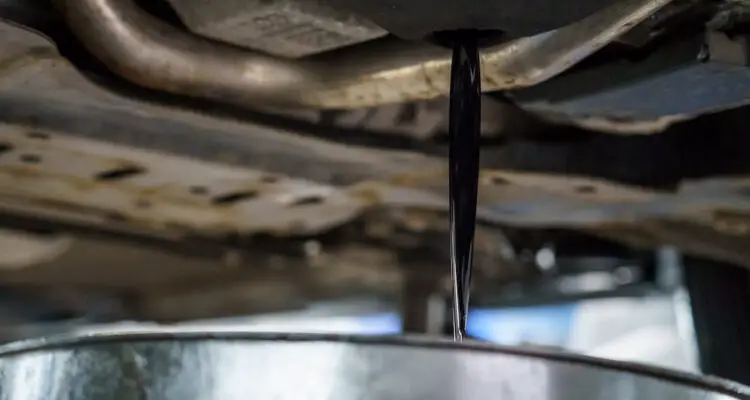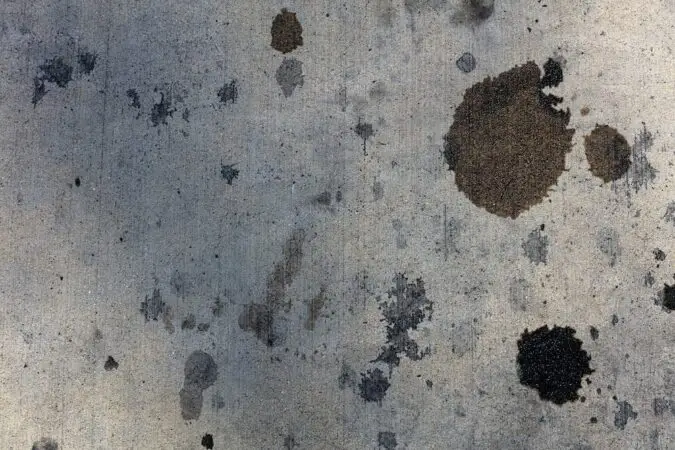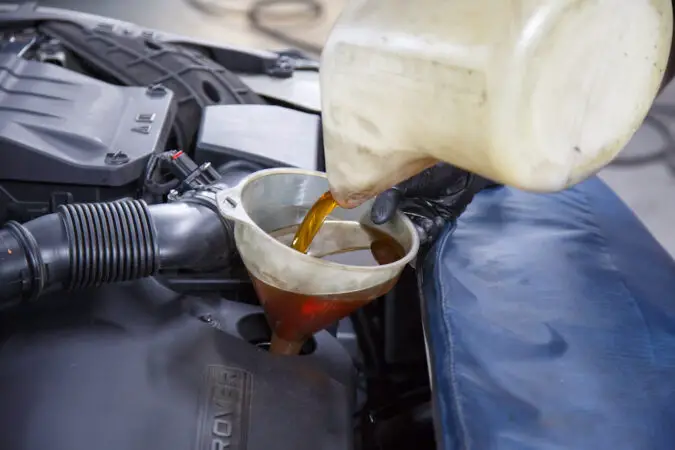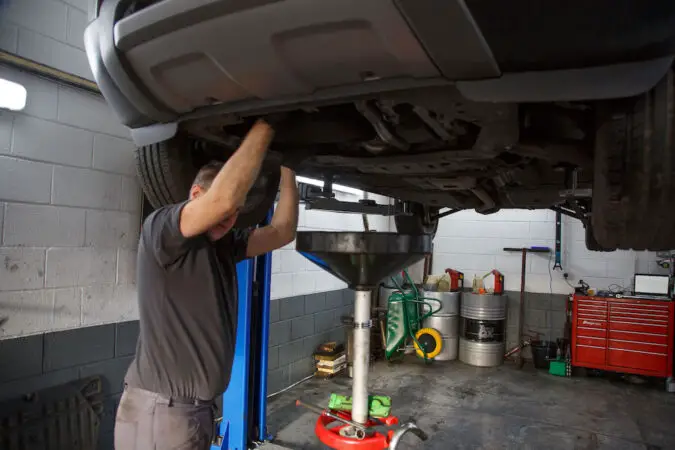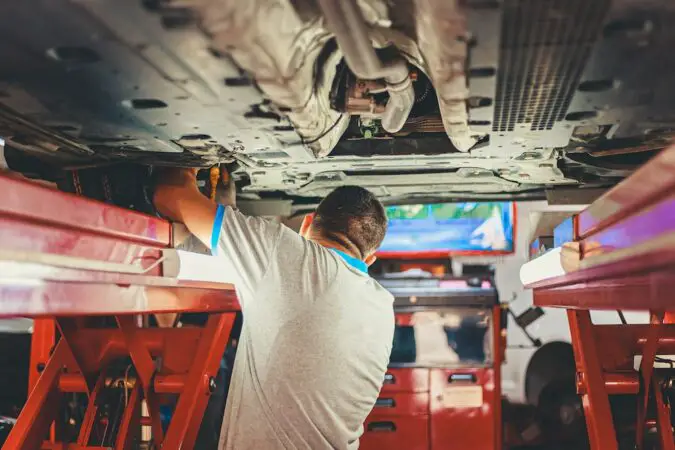If you’ve noticed unexpected oil loss in your car lately, it’s a sign of an oil pan leak in the engine’s lubrication system and should be fixed. Oil leakage is expensive, but it also causes engine failure, so you shouldn’t ignore it.
The oil pan gasket wears with time. It is made of rubber material and depreciates due to exposure to high temperatures from the engine. Oil pan gasket leak is therefore inevitable. You might notice a few car drops in your garage when you park your vehicle for a long time. This is residual oil and is normal. It doesn’t indicate oil leakage.
The signs that your oil pan gasket is leaking may not be as apparent as an oil puddle in your garage. This is why most people mistake oil loss for another car fault. You must know what signs to expect if your oil pan leaks. In this article, I have talked about everything you need to know about oil pan leaks but before then, let’s see the symptoms of an oil pan gasket leak:
Oil Pan Gasket Leak Symptoms
Oil pan gasket leaks can be a big problem in vehicles, and it’s important to identify them quickly. Not only do they result in oil puddles underneath your car, but the oil could also be leaking into your engine and cause serious damage. However, these leaks can be tough to notice, especially if they are small. Here are the common signs of oil pan leaks:
1. Oil Puddles Under Your Car
The most visible sign of a leaking oil pan is the oil puddle in your driveway. Minor oil leaks may not stain your garage, so if this happens, the oil pan gasket has been leaking for quite a while, and you didn’t notice.
If oil accumulates in your garage, it can be hard to remove the stain. You should know that an oil stain in the driveway (otherwise, necessitating that you learn how to get oil stains out of concrete and how to get oil off driveway) doesn’t always signify a leaking oil pan gasket. The oil leak could be from other sources like the crankshaft seal or valve cover. Check the components above the oil pan to identify where the leak is from.
Antifreeze sometimes leaks too. Confirm the stain in your garage is oil before taking any steps to repair it.
2. Smoking Engine
Smoke is a byproduct of combustion in your car engine. In cases of oil leaks, smoking will be more severe. When the leaking oil from the oil pan contacts high temperatures in the machine, it burns and produces a cloud of thick blueish smoke. If the oil gets to the exhaust manifold, the smoking will be intense.
The exhaust is usually very hot when the car is in motion. Oil residue on the exhaust buns produces thick smoke at high temperatures as that generated in your car engine. Oil leakage can damage electrical sensors in your car if ignored.
3. Overheated Engine
The oil pan is attached to the engine for a reason – to lubricate the engine components against fiction. If the oil leaks from the gasket, the engine will overheat since the oil isn’t available to lubricate and cool the engine. The engine’s components will rub against each other and generate extreme heat.
Overheating poses a risk of damage to the engine. Oil pan leaks should be fixed as soon as possible.
4. Low Oil level
Although low oil levels are not a reliable indicator of oil pan leaks, it’s a sign that your engine is losing oil. Oil leakage can be from many sources, so you must thoroughly check before concluding it’s a leaking oil pan gasket.
The oil that lubricates the engine is contained in the oil pan, an unexpected drop in oil levels means oil is leaving the oil pan and is not going to the engine. To check your car’s oil level, pull the dipstick out of the engine. If the oil level is down to the bottom, the chances are that your oil pan gasket is leaking.
The low light indicator in your car instrument cluster indicates that your oil level is low. If you’re driving, the safest thing to do is pull over and check the oil level with the dipstick. The rubber material the oil gasket is made of wears out, so you need to replace it with time.
5. Burning Oil Smell
Burnt oil often gives off a smell. Suppose your car gives off a burnt-oil smell and the oil pan gasket leaks. The oil from the leaking oil gasket flows to the exterior parts of the car engine. Unde high temperatures, it burns off with the smell of fresh oil.
Unlike the burning fat in the machine, oil leaks from the gasket buns with an intense odor because it’s new oil heated to engine operating temperature, although it doesn’t pass through the engine. The smell gets stronger as the oil leak increases. If your car is giving off an unusual burnt oil smell, check your oil levels, and if there’s a significant drop, engine oil is leaking.
6. Oil-Coated Undercarriage
In severe cases, oil pan leaks spread to other parts of the engine throughout the car undercarriage. When your car goes into motion, air blows the leaking oil in the undercarriage and distributes it. Heavy oil leaks mean the undercarriage will have substantial oil residue on it. In some cases, the oil is blown to the exhaust, where it burns off with a noticeable smell at high temperatures.
Oil Pan Leak Repair
If your oil pan or gasket leaks, the best solution is to replace them. Oil pan leaks rarely need a replacement, especially those made with stamped steel. Aluminum oil pans are less flexible than stamped steel, so it’s more prone to damage.
You can replace the oil gasket or pan yourself, depending on the car model. This only applies to vehicles where you can access the oil pan directly without removing so many car parts like exhaust or frame parts or even the entire engine itself. Rear-wheel-drive vehicles typically require engine removal before replacing the oil pan or gasket. You may need to remove the exhaust parts to access the oil pan for front-wheel-drive vehicles.
Before you repair the oil leak, please check the car repair manual. Note that these steps apply to vehicles with direct access to the oil pan. Finally, you should let a professional repair your oil pan leaks but if you’re up to it, follow these steps to fix your oil pan leaks.
Tools Required:
- Jack stand
- Flat screwdriver
- Rubber mallet
- Torque wrench
Step 1: Prepare The Vehicle
- Park your car on a level surface.
- Set the emergency brake, and raise the car’s front end using a jack stand.
- Block the rear tires with a heavy object to prevent unwanted rolling.
- Detach the negative battery cable.
Step 2: Drain The Oil
- Place a container under the engine oil pan.
- Unscrew the oil drain plug from under the oil pan and drain the oil completely.
- If the drain plug is in good condition, put it back on the oil pan once you’re done draining.
Step 3: Remove The Oil Pan
- First, locate and remove any component the manual instructs, which should be cross members, exhaust pipe components, or support brackets.
- Unscrew the oil pan bolts holding the pan unto the engine one at a time.
- Remove the oil pan. If it’s stuck, tap on it lightly using a rubber mallet, and it’ll come off.
Step 4: Inspect The Oil Pan For Holes
- Clean the oil pan mating surfaces thoroughly and scrape off any old gasket material or silicon.
- Wash the oil pan using a cleaning solvent like cold soak cleaner. For stubborn oil stains, use carburetor oil or engine oil cleaner and a wire brush to clean the pan.
- Inspect the oil pan for cracks and holes.
- Place the pan upside down on a flat surface and check the pan flange for bends.
- Look out for gaps between the flange and the surface.
- Straighten out the bends with a rubber mallet.
- If the oil pan is faultless, proceed to remove the oil gasket.
Step 5: Install A New Oil Pan Or Gasket
- If your old oil pan is in good shape, reuse it. Otherwise, replace the oil pan with a new one.
- Place the gasket on top of the pan and insert the bolts through the pan to secure the gasket in place.
- Use a torque wrench to tighten the bolts. Be careful not to over-pull it.
- Reinstall the drain plug and tighten it. Read the manufacturer’s manual on how to pull the drain plug.
Step 6: Refill The Engine With Fresh Oil
- Gently lower the vehicle by removing the jack stand.
- Attach the negative battery cable.
- Fill the engine with the right amount of oil.
Step 7: Start The Vehicle
- Start the engine and let it idle for 15 minutes.
- Turn off the car and let the engine come to cool.
- Check for leaks under the car or use a dipstick to check for oil level.
- If there’s a leak, tighten the drain plug and check again.
Oil Pan Gasket Leak Quick Fix
If you just noticed the oil leak from the gasket or oil pan, use an engine stop-leak additive to seal the rubber seals on the oil pan to temporarily stop oil leakage. To fix the leaking oil pan gasket, fill it with BlueDevil Oil Stop Leak additive.
An engine oil stop-leak additive makes the rubber seals softer to prevent oil from seeping through. BlueDevil Oil Stop Leak seals cracks and holes on the oil gasket. These additives come in handy for an oil leak quick fix.
Also, consider changing the oil drain plug. Constantly removing the drain plug each time you get an oil change affects its lifespan. The thread on the drain plug wears out with use and causes oil leakage from the oil gasket.
Note that a quick fix is only temporary. The permanent solution is to replace the oil pan gasket.
Where Is The Oil Pan Gasket Located?
The oil pan gasket in a vehicle is positioned between the engine’s oil pan and the bottom lip of the engine block. The oil pan is made of rubber material, which acts as a cushion for the oil pan. It also seals the pan against oil leakage. Engine oil is kept in the oil pan, joined to the engine block by an oil pan gasket.
Can I Drive With A Leaking Oil Pan Gasket?
You can drive your vehicle even with a leaking oil pan gasket. A leaking oil gasket will lower your car oil levels, and that could harm your car engine if prolonged, so you must be careful. Maintain optimum oil level in the engine by constantly checking and refilling it with fresh oil.
Oil pan gasket leaks should not be ignored as it has severe complications. If your oil gasket or pan is leaking, it’s best you replace it with a new one to safeguard your engine. Contact a mechanic or technician to fix your oil pan leaks repair or follow the guide in the article to do it yourself.
How Long Can I Drive With A Leaking Oil Pan Gasket?
You shouldn’t drive longer than 10 miles with a leaking oil gasket, except if you carry extra oil to refill the engine. Oil leaks reduce the oil levels in the vehicle. You can’t drive long distances with a leaking oil gasket.
Severe oil pan gasket leaks deprive the vehicle’s engine of the oil it needs for lubrication and cooling. It causes overheating in the engine and subsequently damages if left unchecked.
Is Oil Pan Gasket Leak Serious?
Minor oil pan gasket leaks do not pose an immediate risk to the car engine, but if left unrepaired, the oil leak worsens and can cause engine damage. Fix car engine oil leaks from any source as soon as possible to preserve the engine.
The engine oil is for lubrication to keep the engine parts from overheating as they rub against each other. If the oil leaks away from the oil pan gasket, the engine will be left without oil and overheat. Oil pan leaks also cause intense engine smoking.
Oil Pan Gasket Replacement Cost
The replacement cost varies depending on the car model, but it ranges between $150-$850. The cost of replacing the oil gasket also depends significantly on the work involved in the replacement procedure. The time and effort put into replacing the oil gasket affect the replacement cost.
The oil pan gasket also varies with car models, but the price falls between $110 to $150 for most car models. Note that the labor cost is higher than purchasing the oil gasket. If you don’t have a lot of money to replace an oil pan gasket, you can do it yourself, although this doesn’t work for all car models.
Oil Pan Gasket Leaks: Facts to Know
- An oil pan gasket leak occurs when the seal between the oil pan and the engine loses its ability to contain the oil inside due to normal wear, loose bolts, inadequate or improper gasket sealer, or unclean surfaces.
- Signs of an oil pan gasket leak include oil puddles under the car, low oil lights or readings, smoking from under the car, a burned oil smell when driving, and engine overheating.
- An oil pan gasket leak can be dangerous as engine oil is flammable and a leak can lead to a catastrophic loss of oil pressure, which can damage or ruin the engine.
- Fixing an oil pan gasket leak usually requires replacing the gasket, which can be a simple or complicated job depending on the car model.
- To replace the gasket, the old gasket, and sealant should be carefully removed and replaced with a new oil pan gasket while following the manufacturer’s instructions on the type and amount of sealant to use.
- Driving with a leaking oil pan gasket can be risky for the car as a minor oil leak can lead to a disaster or engine breakdown.
- The cost of fixing an oil pan gasket leak can vary depending on the car model and the complexity of the system, but oil pan gaskets are generally affordable, costing less than a hundred dollars for common cars.
- Regularly check the oil level, bringing extra oil, and carrying a fire extinguisher can help when driving with a leaking oil pan gasket.
- An oil pan gasket leak isn’t usually a quick fix, but sometimes, tightening loose bolts can stop the leak without changing the gasket.
- A new oil pan gasket may come in a kit with new bolts, new sealant, and detailed instructions for replacing the gasket.
Oil Pan Leaks – Frequently Asked Questions
Here are some popular FAQs:
What Causes Oil Pan Gasket To Leak
Over time, the oil pan gasket wears out and leaks oil onto the oil pan. The gasket is made of rubber and depreciates with the use, causing oil leakage to other engine parts. Another common cause of oil pan gasket leaks is impact damage. If an object sticks to the oil pan, the seal on the oil gasket can go bad, causing it to leak. Sometimes, it’s not the oil gasket that is faulty but the oil pan itself. Road debris or even an accident can cause impact damage to the oil pan. The oil pan will have holes in it and eventually cause oil leakage. However, oil on the oil pan could come from other places like the bolts. If the bolts on the oil pan are leaking oil, tighten the bolt to reduce the oil leakage. A faulty oil gasket should be replaced.
How To Fix Oil Pan Leak
If your oil pan leaks, the fault could be from the oil plug drain or a problem with the gasket or seal between the engine block and the oil pan. In most cases, you can repair the leak by replacing the drain plug, tightening any loose bolts, and replacing a bad gasket or seal. The oil pan is the lowest part of the engine and is exposed to extreme temperatures. Oil pan leaks can be caused by various factors that include worn-out gaskets and loose bolts. If left unrepaired, these leaks will cause damage to your engine over time.
How To Stop Oil Pan Leak
You can repair the leaking part, such as an oil pan or gasket, or replace it. Repairing a leak is usually the better option because it’s easier and cheaper. In some cases, you may need to replace a part because it’s not worth fixing or the claim is beyond repair. If the oil pan leak is from another source like loose oil pan bolts, gently tightening the bolts with a torque wrench will reduce the leakage. The oil pan drain plug can also cause oil pan leaks. You may have to replace the oil pan drain plug with a new one. If you’re going to try and repair your leak, use additives like engine oil stop-leak sealant. The additive softens the rubber material of the oil gasket and stops leaks temporarily. Oil pan leaks put your car engine at risk of damage and should not be ignored.
How Much To Fix Oil Pan Leak
The cost to fix an oil pan leak will depend on several factors, including the model of the vehicle and where you take it. On average, fixing an oil pan leak is between $150 and $850. The repair cost covers the price of a new oil gasket or oil pan, and the labor cost is often high. Repairing an oil pan leak can be expensive because the engine must be removed from the vehicle. The cost also depends on whether or not the leak causes internal engine damage. If not, only a new gasket may be required to fix the leak. If your leaking gasket causes internal damage, you may need a complete overhaul of your engine, costing $2,500 and $4,000. This includes replacing parts like pistons, valves, and other components that may have been damaged due to lack of lubrication from your oil pan.
Will Tightening Oil Pan Bolts Stop Leak
If the oil pan bolts are loose, causing the oil pan to be snug, tightening the bolts will stop oil leakage. In cases where the oil pan or oil gasket is faulty, tightening the oil pan bolts will not prevent the oil leakage. The solution is to place the oil pan or gasket. To tighten the oil pan, start by removing your drain plug on top of your oil pan – there should be a large flathead screwdriver handy if you don’t already have one – and allow all of the oil to drain out into a container underneath your vehicle while keeping an eye on how much comes out so that you know when it’s done draining. Now that there is no more oil in your pan tighten each bolt using a torque wrench and socket set according to manufacturer specifications for that particular bolt type.
Final Thoughts On An Oil Pan Leak
Oil pan leak symptoms could be the apparent oil puddle under your car or unusual engine smoke. It is worth noting that most of these symptoms can be associated with other issues, so you don’t want to conclude that they mean there’s an oil pan gasket leak. However, if you detect a continuous drop in the oil levels, this could be the problem, and it means the oil pan or gasket needs replacement.
